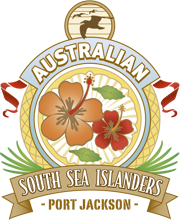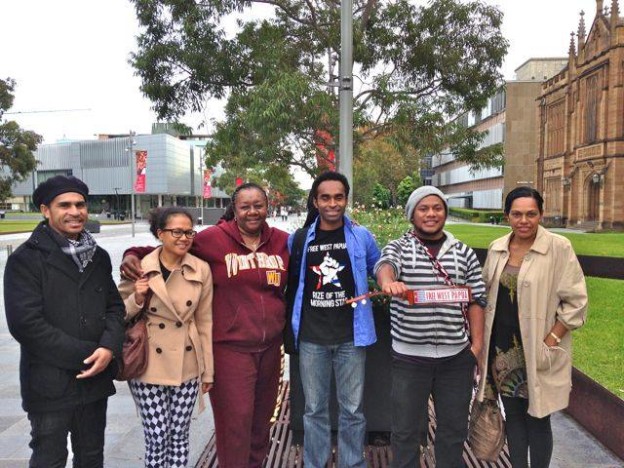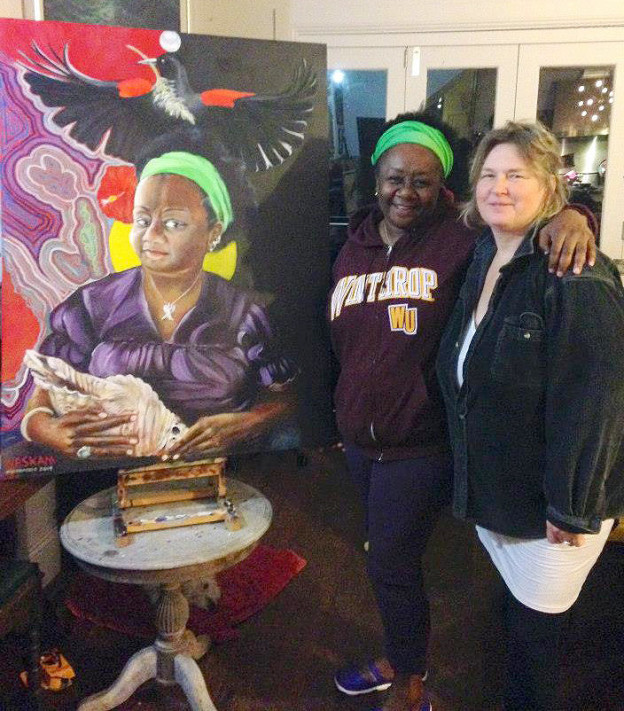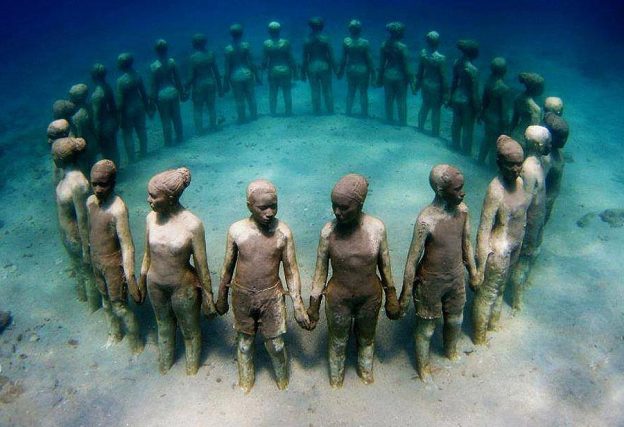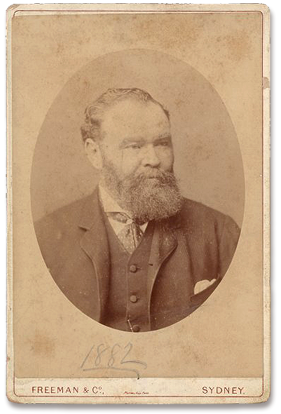West Papua Activism conference participants Oceanscapes cooperations across the Pacific – Australian Association for Pacific Studies Conference 22-26 April, 2014 Macleay Museum. Ronny Kareni & West Papua Activism & Mereani Navukitu – AAPS 2014
‘BLACKBIRD’ Archibald prize entry portrait of Emelda Davis
Interview with Prof. Gracelyn Smallwood – Nelson Mandella
Interview with Prof. Gracelyn Smallwood – Nelson Mandella a humble freedom fighter / Torres News By MARK BOUSEN.
The late Madiba Nelson Mandela was a humble freedom fighter who promoted truth, justice and reconciliation with violence, a prominent world, human rights figure has said.
Professor Gracelyn Smallwood, who last month received a United Nations Award for her 45 years of work and service for national and international health and human rights, told the Torres News at the Australian South Sea Islanders (ASSI) forum at Tweed Heads on the weekend.
Professor Smallwood, who lives in Townsville, met Mr Mandela in 1997 when she and Dr Chris Sarra were VIP guests of the South African President for the 20th anniversary of the death in custody of the late Steve Biko. “We were among the millions and we were waving the Aboriginal and Torres Islander flags near Mr Mandela. “The flags were spotted by Mr Mandela’s good friend Kwame Ture, the former Black Panther who was previously known as Stokely Carmichael, who was seated next to Mr Mandela. “Mr Mandela sent one of his guards who was carrying a machine gun and with a dog to invite us to sit in a vacant chair next to him. “As there was only one seat, Dr Sarra and I decided to take a rain check and would meet the President at a small function that night.”
Professor Smallwood, who has family in the Torres Strait, recounts that President Manela was accompanied by journalist Donald Woods, who promoted and assisted with the movie Cry Freedom, the movie based on Biko’s live and death. “Mr Mandela made a humble statement about obtaining reconciliation with the truth. But in Australia, we’re trying to have reconciliation without the truth. “President Mandela also played a prominent role in the mediation with (Libyan leader) Colonel Gaddafi over the Pan Am incident (also known as the Lockerbie bombing).
“In a sense, my father, Archie Smallwood, did in Australia what President Mandela did in South Africa about human rights.” The day following the celebrations in South Africa and Professor Smallwood and Dr Sarra travelled to Libya via Malta to attend a human rights conference where Professor Smallwood talked about how the land rights fought for and won by the late Eddie Koiki Mabo were being watered down in Australia. “This created a massive breakdown and disharmony in Aboriginal and Torres Strait Islander families.”
Professor Smallwood said there will be harmony only when reconciliation is achieved with truth. “Reparation and reconciliation needs to be made to the First Families, Aboriginal/Torres Strait Islanders/South Sea Islanders as this country has, in the last 230 years, become one of the wealthiest countries in the world on the back of black slavery.”
Professor Smallwood is a registered nurse and midwife, prominent figure in Indigenous Mental health and holds a Master of Science Degree in Public Health, as well as a PhD in First Nations Australian health and human rights. “The United Nations Award is a real honour as I have retired, but it also reflects on my parents, particularly my father who was from the Juru Birrigubba homeland (in the Bundaberg district) and was sent to the infamous Palm Island at a young age under the Aboriginal and Torres Strait Islander Protection Act,” she said.
A young woman of charm, ability and undoubted influence!
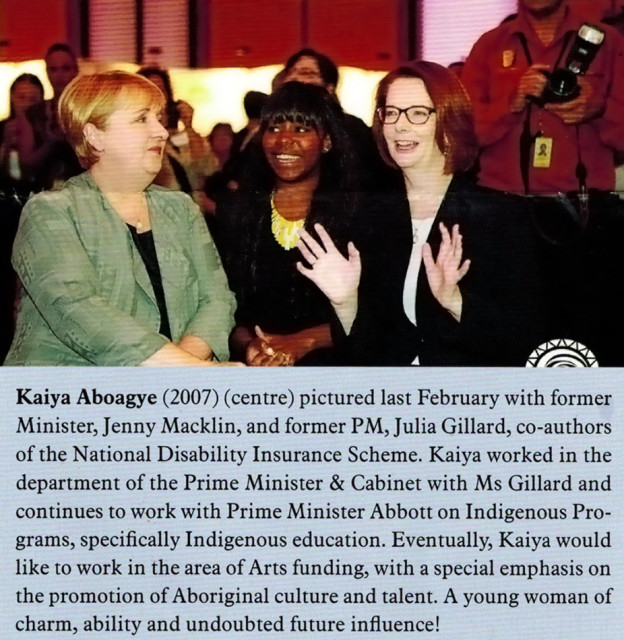
Kaiya Aboagye (nee Oliver) with Prime Minister & former minister – an accomplished Aboriginal, Torres Strait, Australian South Sea Islander and African Women.
Kaiya Aboagye (2007) (centre) pictured last February with former Minister, Jenny Macklin, and former PM, Julia Gillard, co-authors of the National Disability Insurance Scheme.
Kaiya worked in the department of the Prime Minister & Cabinet with Ms Gillard and continues to work with Prime Minister Abbott on Indigenous Programs, specifically Indigenous education.
Eventually, Kaiya would like to work in the area of Arts funding, with special emphasis on the promotion of Aboriginal culture and talent.
A young woman of charm, ability and undoubted influence!
Australia Day and the war canoe
The first national Australia Day was held 100 years ago and involved, among other things, a war canoe from the Solomon Islands.
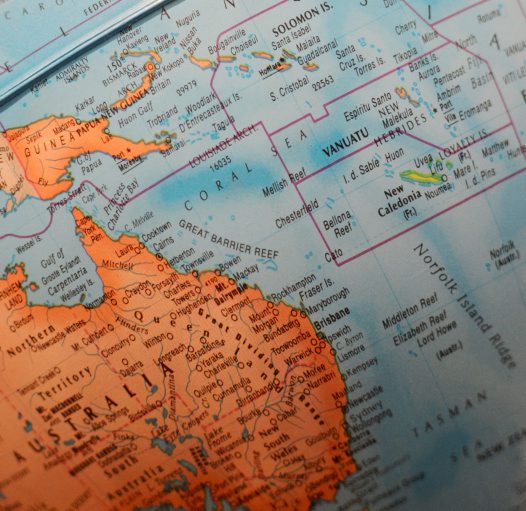
Scott Mitchell © Australian Museum
For some people, Australia Day evokes thoughts of Governor Phillip, Circular Quay and red-coated soldiers saluting the British flag. For others, it’s the beach, the barbecue and the public drunkenness lamented in the media each year.
It probably wouldn’t make you think of a traditional head-hunter’s war canoe from the Solomon Islands, and yet there is a connection, not only to Australia Day, but to that other national icon, the ‘Australian crawl’ swimming stroke. Neither Australia Day nor the Australian crawl are quite what they appear.
Australia Day
As we all know, Australia Day officially commemorates the arrival of the First Fleet of British ships at Port Jackson and the first raising of the British flag there by Governor Phillip. Anniversary commemorations began early: 26 January was noted in Sydney calendars and almanacs by 1804 and an official annual commemoration had begun by 1818.
In some respects these early celebrations resembled the Australia Day holiday of today, with a regatta on Sydney Harbour, celebratory dinners and, according to the Sydney Herald in 1838, a degree of public ‘drunkenness and riot’.
But unlike today the event was called Foundation Day or First Landing Day, the name ‘Australia’ not yet being in general use. And unlike today the celebration had a distinctly British character, with toasts at the annual dinners commemorating such British institutions as ‘The King’, ‘the Queen’, ‘the British Army and Navy’, and ‘the Mother Country’.
The twenty-sixth of January or Anniversary Day long remained a Sydney rather than national event as each self-governing colony celebrated the date of its own foundation. Even after Federation in 1901, the now united states and territories continued to celebrate their separate anniversary dates (and some still do).
Despite various efforts to create a national day of celebration, the first nationwide Australia Day was not established until the First World War. Fuelled by national pride and patriotic ardour for the Gallipoli campaign, the first nationwide Australia Day was held on 30 July 1915. It was marked by parades, public concerts and other activities across the country to raise funds for the Red Cross and wounded soldiers.
The event was not repeated, and it took another 20 years before the various state and territory governments agreed to celebrate a united Australia Day on 26 January 1935.
But it was on this first national Australia Day in July 1915 that Harry Wickham and his canoe enter this story.
The war canoe and the great Australian crawl
Harry Wickham was born in the Solomons in 1882 on the island of Hobopeka in Roviana Lagoon. The son of an English plantation owner and Melanesian woman from Bougainville, Harry lived closely with the local people, including the local ceremonial and war leader, Chief Hingava. Roviana Lagoon was widely known for the large scale, ritualised headhunting carried out by its residents, and Chief Hingava was one of its fiercest proponents. Using tomoko or war canoes, large parties of up to 500 warriors from Roviana Lagoon raided islands throughout the western Solomons, returning with human heads and slaves.
Not surprisingly, these events made a vivid impression on the young Harry Wickham: later in life he recalled seeing canoes full of warriors and their victims returning from the raids ‘… ornamented with many smoke-dried human heads, the eyes and ears inlaid with mother of pearl’.
Just like the other children, Harry swam and dived in the lagoon, learning an overarm swimming stroke and kicking-leg movement known locally as tuppa te pala. Sent to boarding school in Sydney at the age of six, he became a regular swimmer at Bronte Baths, bringing the distinctive stroke with him. Onlookers, who were more familiar with what we would now call the breaststroke and the ‘dog paddle’, were astonished. One eyewitness reported that he ‘… swam with his head held fairly high, turning it quickly from side to side breathing with each complete stroke, his woolly head apparently not getting wet … his arm action was very fast …’.
A few years later Harry was joined in Sydney by his younger half-brother Alick who gained attention with the stroke in an under-10s race at Bronte. The prominent swimming coach George Farmer reportedly exclaimed, ‘Look at that kid crawling!’ – spawning the name Australian crawl, the world’s fastest swimming stroke, which evolved into the freestyle stroke we know today. Alick went on to become a champion swimmer and diver.
The stroke was taken up by champion Australian athlete Dick Cavill, who set a new world record at an International Championship in England in 1902. Nearly a third of the 143 Olympic gold medals subsequently awarded to Australia have been in freestyle, making it our most successful Olympic sport. Fittingly, one of our greatest Olympic swimming champions is Tracey Wickham, a distant relative of Harry.
Return
After finishing his schooling in Sydney, Harry returned to Roviana Lagoon, working as an accountant, establishing a copra plantation and starting a large family (with six wives). By the time he returned, the colonial authorities had discouraged the practice of headhunting, with the last raid from Roviana occurring in 1902, just as the Australian crawl surged onto the international stage.
Local people maintained the knowledge of how to make the tomoko (they are still made today), and Harry commissioned one in 1912 for the Christmas races at the local Methodist Mission. In 1915 he despatched the war canoe to Sydney as a contribution to the first national Australia Day, a fundraising effort by the Australian Red Cross for wounded soldiers at Gallipoli. The canoe was placed on display at the Australian Museum and the Red Cross Committee agreed that if £1000 was subscribed, the canoe would be handed over to the Museum Trustees, which it eventually was.
At more than 14 metres in length, made from stained black timber planks and inlaid with long lines of dazzling white shell, the canoe became a favourite for generations of Museum visitors until it was taken down and placed in offsite storage in the 1980s.
Credit
While most schoolboy sporting careers are quickly forgotten, Harry might well have pondered how a Melanesian swimming stroke first demonstrated by Solomon Islanders came to be known as the Australian Crawl. Just before his death in 1962, he told a journalist, ‘It’s a pity the true tale has not been told. It would be nice if Alick and I could get a nod or two in our direction for the way the world is swimming now.’
Perhaps it was the prevailing racial attitudes of the day. One of the first actions of the newly federated Australian Parliament in 1901 was to expel the 7500 Pacific Islanders recruited or enslaved by North Queensland sugar plantation owners, followed only six days later by legislation that ushered in the White Australia Policy.
Australia Day is our largest annual civic event, yet holds an ambiguous place in the minds of some Australians. Many Aboriginal people regard it as a day of mourning, rather than of celebration, and organisers have struggled to make the day relevant to all Australians, not just those with British origins.
In that context there is something quite revealing about the story of Harry Wickham and his canoe. Even in the early twentieth century, with the White Australia policy in full force, a Solomon Islander was able to contribute to events that have helped shape our national identity.
While Australia Day is an opportunity to celebrate our multicultural identity, it is also a chance to reflect on the less apparent multicultural identity of the past. Happily, generations of immigrants from the Pacific have since forged a successful place in Australia and, like Harry’s freestyle stroke brought from the Solomons, now represent a significant part of our cultural life.
Harry’s war canoe will eventually be back on display in what will be the Museum’s new offsite storage facility in western Sydney.
Dr Scott Mitchell, Head, Culture, Conservation and Consulting
Australia Day and the war canoe is an edited version of a story that first appeared in Explore magazine.
Further reading
S Aswani, 2000. Changing identities: Roviana predatory headhunting. The Journal of the Polynesian Society 109(1): 39–70.
A Jackson, 2008. Australia Day 1915. Australian Heritage (Autumn) pp 9–11.
E Kwan 2007 Celebrating Australia: A history of Australia Day. http://www.australiaday.org.au/australia-day/history/
G Lawson & R Evans, 1965. The Brothers Wickham showed the world a new way to swim. pp 17–20 in J Taylor (ed) Pim’s Pacific: Stories from the South Seas. Pacific Publications, Sydney.
C MacGregor & H Mackay, 2013. Boat in a bubble, pp 38–39 in Feathers of the Gods and other stories from the Australian Museum. Australian Museum, Sydney.
G Mackaness, 1960. Australia Day. Royal Australian Historical Society 45(5): 266–8
– See more at: http://australianmuseum.net.au/blogpost/Museullaneous/Australia-Day-and-the-war-canoe#sthash.T4VrIeTC.oGRO7xCP.dpuf
West Indies underwater monument to slavery.
Grenada, West Indies. Located in Grenada’s Moilinere Bay, Jason de Caires Taylor’s underwater sculptures are a momument created to pay homage to the hundreds of slaves that sought freedom or were forced to jump overboard slave ships travelling through the Middle Passage from West Africa to the Americas and the Caribbean.
ASSI National Body Constitutional Development Meeting 2014
Dear ASSI Community Leaders, Family and Friends,
Greg Sutherland, the chair of the National Australian South Sea Islanders Governance Working Group, is travelling from Mackay to Sydney to consult and gather feedback from ASSI communities/families/friends in Sydney and surrounding areas on the ASSI National Body Constitutional development.
He has asked me to advise the community of the confirmed meeting date and venue so that everyone may be involved.
The model that has been agreed on by a significant number of community consultations to date is the Federation model to represent our people.
Federation Model Definition:
A federation is a country with a united central government that is made up of separate units that each control its own internal affairs. The United States is one example of a federation.
Many countries, such as Canada, Australia, Mexico and India, are federations. The Forum of Federations is an international organization that strives to share advantages and challenges of the federation form of government among its members.
The forum also works with countries struggling to move from more authoritarian forms of government to the more democratic federation model by providing advice and support. Federations allow states with diverse ethnic and cultural groups to unite into strong countries with centralized governments.
Our pro bono law firm, Gilbert & Tobin, have kindly drawn up a community input / feedback questionaire which will be much of the topic for discussion at the meeting and can be downloaded HERE.
Those of you who cannot attend, may want to put questions regarding the attached document Q&A in writing or provide your answers to the questions contained in the form by filling in the far right hand blank column and returning it no later than 1 week prior to the meeting date.
Return the questionaire by emailing your completed copy to both of the following email addresses:
To Greg Sutherland – email: NASSIWG@skillstm.com.au and CC assi.pj@gmail.com
so we can collate all information for the meeting here in Sydney.
An ESTIMATED time frame for adoption of the draft constitution and election of our national delegates is expected to take place in September / October 2014.
Please understand that the draft constitution is not set in stone it is a basis to start from and will change inevitably to represent our community / organisations needs as we develop our national representation.
Time and date for ASSI National Body Constitutional Development Meeting 2014:
Venue: St Johns Church Hall – Glebe
Address: 132 St. Johns Road Glebe, Sydney NSW
Time: 12 noon to 6pm
Refreshments provided,
(RSVP by Monday 16th June 2014 for catering)
We look forward to seeing you at the meeting and hearing your feedback.
John Mackay – Blackbirder
This weekend Australian South Sea Islanders are holding WANTOK in Mackay, the last of three national workshops aimed at bringing together the diverse Islander community. The first of their ancestor were brought to Mackay in 1867, just a few years after the founding of the settlement in 1860.
What few Mackay residents realise is that John Mackay, a leading member of John Macrossan’s 1860 expedition which “discovered” the Pioneer Valley, went on to work in the labour trade and that Mackay, the city, owes its name to a Blackbirder.
Born in 1839, as a young man John Mackay was involved in mining, exploration and pastoral ventures. He stocked Greenmount run in the valley but had to sell out in 1863. Mackay had previously served on one Pacific voyage as a purser while still in his teens, which led him to gain his master’s certificate in 1865 and for the next eighteen years he commanded various ships in the Pacific trade. A Captain of several vessels recruiting Melanesian labourers, one was Sir Isaac Newton in 1868 on a voyage bringing Melanesian labourers to Gladstone. Records also suggest that he was twice master and recruiter on Queensland vessel the Flora in 1875.
He was also on another voyage, either that of the Daphne or the Carl, and was master of Waiau in the Fiji labour trade. John Mackay also spent some years in Fiji on a sugar plantation before becoming harbour master in Cooktown (1892-1902).
Back in 1978 and 1979 when this labour trade connection was aired in the pages of the Daily Mercury, his granddaughter Margaret Mackay defended what the family believed to be the honour of John Mackay (D.M. 25-4-1979). A trip, thought to be on the Daphne, was discussed. The 1868 Australian Daphne  voyage is well known because of a NSW Royal Commission and there is no evidence that John Mackay on this voyage.
The Mackay family has correspondence from Archibald Watson, later a professor of anatomy in Adelaide, who worked as crew on the Carl in 1871-72. In 1914 Watson wrote to John Mackay saying that had he not used the ship’s guns, the vessel would certainly have been taken and all on board killed. To avoid prosecution, Watson left for Europe straight after the Carl voyage. The Carl made two voyages recruiting for Fiji. The first was the most horrific voyage in the Melanesian labour trade. Fifty Islander recruits were shot and about twenty were wounded on the ill-fated voyage. Was John Mackay on board, and if not when did he turn a ship’s guns on Islanders?
John Mackay was badly treated by the Queensland government. In 1864 the Governor had promised to give him a financial recompense for his part in discovering the Pioneer Valley, but the government never honoured this pledge. John Mackay protested this on several occasions, and this is probably why in later years he presented himself as leader of the 1860 expedition. Evidence from the Macrossan family suggests that John Macrossan was the real leader.
As chairman of the Queensland Marine Board (1902-12) and finally harbour master of Brisbane until his death in 1914 he became a venerable figure, held in high regard, but in the 1860s and 1870s he was a young man seeking his fortune on land and at sea.
The 1860s Queensland labour trade was confined to the New Hebrides (Vanuatu) and the Loyalty Islands (now in New Caledonia). Historians believe that there was a great amount of deception and trickery involved and that kidnapping and violence was rife in the early years, although not universal. Many of the labour recruits from the Loyalty Islands and southern New Hebrides had already worked as crews on inter-island shipping.
The word Blackbirding is used to describe the early years of the labour trade. Even by his family’s admission, John Mackay was involved in at least one very violent incident, and there were official French protests over the Sir Isaac Newton voyage.
John Mackay deserves to be remembered as a 1860s explorer and pastoralist, but let us also remember that, similar to Robert Towns, founder of Townsville, his name is connected to the Blackbirding years.
Professor Clive Moore will be speaking at Wantok on Day 2 of the program Saturday the 29th March in his capacity as an advisor to the Australian south Sea Islanders (Port Jackson) historical panel in also sharing Mackay Births Deaths and Marriages Register as well as DATSIMA finding family record complimented with a Q&A.
For interviews call Professor Clive Moore mobile: 0419 676 123
University of Queensland
The complete WANTOK 2014 program can be downloaded HERE.
Photo courtesy of The National Library of Australia
John Mackay – Blackbirder Posted 27 March 2014.
